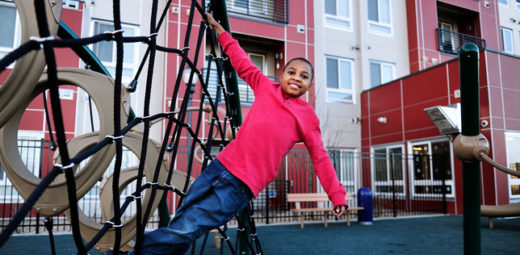
May 24Staying Active with Mercy—Happy Health & Wellness Month
A healthy life shouldn’t be a luxury. Unfortunately, for too many people that earn low incomes, a healthy lifestyle can be hard to come by. To eat well and exercise, it takes a little extra time and money—the things that families, seniors, and veterans in need don’t always have in surplus. Mercy Housing and many other mission-driven partners are getting creative to find solutions to this issue because healthier people can build healthier communities.

10 to 15 Years?
That’s a long time, and 10 to 15 years is the difference in life expectancy between people earning low versus people earning high incomes. One of the most comprehensive, recent studies led by a Stanford University economist analyzing this trend, found this startling statistic. Experts cite a variety of reasons—one of the biggest being exercise.
Middle- and upper-income earners have the resources to squeeze workouts into their schedules and can afford better quality food. Lack of financial security is closely associated with reduced physical activity. U.S. counties with the highest rates of poverty have the highest rates of sedentary lifestyles, according to the University of California in San Francisco (UCSF). Sedentary lifestyles lead to chronic health problems like obesity.
Nancy Adler, Ph.D., director of UCSF’s Center for Health and Community says, “It’s difficult to exercise in an unsafe neighborhood, or to eat well in a neighborhood where healthy foods are either not sold or are more expensive than unhealthy options.”
When people are unhealthy, they’re lives become burdened in many ways. That can affect them negatively as well as their social circles causing them to miss work, school, and other opportunities. Worst of all, it’s unjust. These challenges to finding a healthy life, cause chronic health problems that are preventable.
Health Disparities
All these income-based differences in health and exercise create health disparities. The Centers for Disease Control and Prevention defines health disparities as “preventable differences in the burden of disease, injury, violence, or opportunities to achieve optimal health that are experienced by socially disadvantaged populations.” Healthcare professionals, exercise experts, and even anthropologists are proving that stopping disease before it starts — prevention – is better for long-term health and is cheaper for the individual and society as a whole. Diet and exercise are the best ways to avoid and prevent chronic diseases.

Making Moves
Mercy Housing and our community partners are working hard to help low-income people find ways to stay active so that they can live longer, more productive lives. We offer a variety of health and wellness Resident Service programs. The social interactions that accompany these classes are some of the greatest benefits that compliment the physical and mental gains as well.

In 2018 alone, residents participated in 1,581,955 minutes of physical activity—that’s equivalent to three years of combined exercise! Mercy Housing provides several classes specific to seniors, such as the Matter of Balance, Tai Chi, and even yoga classes.

We don’t view exercise and wellness as extra but rather as an essential part of life. Nearly four decades of providing affordable homes to people in need have given us a deep understanding of the relationship between good health and success in the world. There are a lot of opportunities for you to get involved. We encourage you to contact our volunteer coordinators, if you’d like to teach a class or volunteer with our Resident Services programs—you can help those in need to stay active.
No related posts.
Stay Up To Date
Get news on Mercy Housing and inspiring stories of change delivered to your inbox.


